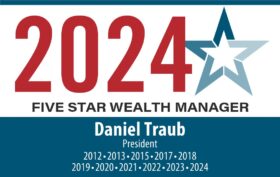The stock market turned in a terrific first quarter of 2024, rising 10.5% as measured by the S&P 500.
It didn’t make much difference which sectors you were invested in as most returned close to the S&P. The only laggards were utilities (+3%), defense (+4%) and real estate (-1%), none of which are in our portfolios.
What made more of a difference than sector were market cap (i.e. large versus small) and geography. Small stocks and international stocks were both up about 5% for the quarter, which is great… except as compared to the S&P 500!
Bonds, on the other hand, did not do very well. The Agg Bond Index was down 0.8% in the first quarter.
Whether you made money in bonds hinged on maturity (long-term bonds -1.6%, short-term bonds +0.8%) and credit quality (Agg Index -0.8%, high yield +1.7%).
Getting back to stocks, the market has been humming along quite well since the most recent bottom in October 2022, rising 46% since then.
Many market observers take this strong performance as an indication that the market can’t possibly keep this pace up and therefore must be over-valued and due for a fall.
They fail to remember that just prior to this rise the market had fallen 24% in the first nine months of 2022.
When you put it together the S&P 500 is up 14.4% since the start of 2022, which translates to an average annual return of 6%. Over this same time period international stocks had an average annual return of just 3% and small cap stocks were actually down 1% per year.
Doesn’t sound so frothy now, does it?
While it is fair to say that the market won’t keep rising at its recent pace, that doesn’t mean it is due for an imminent fall, either.
I am not going to make the argument that the market is cheap. It is not. The price/earning ratio is a bit high and the yield curve has been inverted since the summer of 2022.
Still, economic activity continues to impress and the American Consumer has been remarkably resilient.
The focus today is the same as it was in 2022. What will the Fed do?
Same player, different question.
In 2022 we were hoping the Fed would raise interest rates with just the right amount of finesse to curtail inflation but not cause a recession (i.e. a soft landing). At this point it seems they may have succeeded.
Today we want to know when the Fed will start lowering rates.
The key to when lies with inflation and, by extension, bond yields.
The Fed lowering rates would signal that inflation is under control.
Lower rates are good for stocks prices, since stocks are valued on a discounted cash flow basis.
Market movements these days hinge on the slightest hint of when the Fed will lower rates. Most economists think that will be some time in 2024.
The yield on 10-year Treasurys peaked at 5% in October 2023, troughed at 3.9% in December 2023, and currently sits at 4.3%.
What we don’t want to see is a return to a 5% yield, because that means inflation is picking up again.
Tempo Financial Advisors’ 1st Quarter Investment Performance
Tempo Lifestyle returns ranged from 5.5% for conservative accounts to 7% for aggressive accounts. These figures are in line with benchmarks.
Those of you who have been with Tempo a while know that I am always happy to keep up with the markets during the strong up periods such as the first quarter. If we can do this
and protect value on the down side (such as the first nine months of 2022) we will be successful over the long run. Looking good!
Tempo’s two income strategies, Dynamic Income and Diversified Income had terrific quarters by any measure. They were up 4% and 2.3%, respectively, which was between 3.1% and 4.8% better than the Agg Bond Index, which was down 0.8%.
Making money in a down market is every Investment Advisor’s dream. (Ok, I can’t speak for all Investment Advisors, but it is certainly my dream.) It doesn’t get any better than that!
The same is true over the past few years. Since the start of 2021 Tempo Diversified Income and Dynamic Income both returned an average of 2.5% per year. Compare this to the Agg, which lost 3.2% per year over the same period.
That is outperformance of 5.7% per year for more than a three-year period. I call that a home run!
Reminder
Please contact us if there has been a change in your financial circumstances that would warrant a fresh perspective on your portfolio.
Daniel J. Traub

